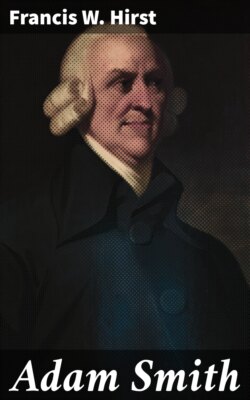Adam Smith

Реклама. ООО «ЛитРес», ИНН: 7719571260.
Оглавление
Francis W. Hirst. Adam Smith
Adam Smith
Table of Contents
CHAPTER I. EARLY YEARS
CHAPTER II. THE BEGINNING OF A CAREER
CHAPTER III. THEOLOGY AND RELIGIOUS ESTABLISHMENTS
CHAPTER IV. THE THEORY OF MORAL SENTIMENTS
CHAPTER V. IN THE GLASGOW CHAIR—THE LECTURES ON JUSTICE AND POLICE
CHAPTER VI. GLASGOW AND ITS UNIVERSITY
CHAPTER VII. THE TOUR IN FRANCE, 1764-66
CHAPTER VIII. POLITICS AND STUDY, 1766-76
CHAPTER IX. THE WEALTH OF NATIONS AND ITS CRITICS
CHAPTER X. FREE TRADE
CHAPTER XI. LAST YEARS (1776-1790)
Footnote
INDEX
Отрывок из книги
Francis W. Hirst
Published by Good Press, 2021
.....
The most valuable part of Adam Smith’s critical lectures has been preserved in an essay on the Imitative Arts, which I should judge from internal evidence to have been drafted at this time, but to have been revised and improved in later years. Considering that neither Burke’s essay on the Sublime and Beautiful nor Lessing’s Laocoon had then appeared, we cannot but admire the originality he displayed in analysing the different effects produced by sculpture, painting, music, and dancing, and in distinguishing the different pleasures that attend the various kinds and degrees of imitation. He works out with much ingenuity the theory of the difficulté surmontée by which Voltaire accounted for the effect of verse and rhyme. Smith extends this principle to other arts, and seeks, always cleverly, often successfully, to show that much of our delight in art arises from our admiration for the artist’s skill in overcoming difficulties. He declares that a disparity between the imitating and the imitated object is the foundation of the beauty of imitation. The great masters of statuary and painting never produce their effects by deception. To prove this, he refers to the rather unpleasing effect produced by painted statues and by the reflections of a mirror. Photography would have supplied him with another illustration.
It may here be said that, though judged by modern standards of criticism Smith’s taste was faulty, yet all his favourite authors are in the first rank, and there is no instance recorded of his having bestowed praise on anything bad either in prose or poetry. “You will learn more as to poetry,” he once said, “by reading one good poem than by a thousand volumes of criticism.” Wordsworth in one of his prefaces calls him most unjustly “the worst critic, David Hume excepted, that Scotland, a soil to which this sort of weed seems natural, has produced.” The Lake Poet, who did not distinguish between the quality of the “Ode on the Intimations” and “Peter Bell,” was probably thinking of some literary anecdotes that appeared in The Bee in 1791 after Smith’s death. The writer, who may or may not be trustworthy, is only repeating table talk. He mentions that Smith depreciated Percy’s Reliques and some of Milton’s minor poems. With regard to blank verse, Smith said: “they do well to call it blank, for blank it is. I myself, even I, who never could find a single rhyme in my life, could make blank verse as fast as I could speak.” From this censure he always excepted Milton; but he thought the English dramatists should have used rhyme like the French. Racine’s Phèdre appealed to him as the finest of all tragedies. Voltaire was his literary pope. Oddly enough, his first publisher’s commission was to collect and edit (anonymously, of course) for the Foulis Press an edition of the poems of a well-known Jacobite, Hamilton of Bangour. The book was published in 1748, and contained the “Braes of Yarrow,” which Wordsworth called an exquisite ballad. Hamilton had played poet laureate to the Young Pretender in 1745, and was still an exile in France. In 1750, when the poet was pardoned, he struck up a warm friendship with his anonymous editor, and (according to Sir John Dalrymple) Smith spent with him “many happy and flattering hours.”
.....